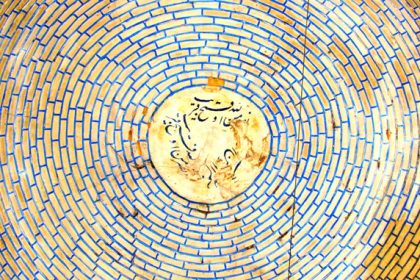Hegmatane ancient site of Hamedan is the last work of Iran, which was registered internationally with a lot of struggle.
After years of efforts and with many margins, the Hegmatane ancient site of Hamadan was finally included in the list of UNESCO World Heritage Sites.
Hegmatane had been waiting for the world registration for years, and along with it, a part of the historical fabric of Hamedan city was also supposed to be a world registration. A few weeks before the start of the meeting of the UNESCO Cultural Heritage Committee, it was clear that this case will face various tensions and in the best case, only the Hagmataneh site will be added to the UNESCO World Heritage List as a single work.
The historical context of Hamedan city, despite its many historical values, lost its chance to be globalized due to the management situation and on the other hand, the insistence of the managers of the Ministry of Cultural Heritage to dogmatically register. Recently, an official of the Ministry of Cultural Heritage has announced that the global registration has been done with political bargaining and even the institutions of Hamedan province do not have a specific budget for the protection of this valuable site.
Despite the politics of the game and the decisions of the upper bodies in the process of world registration cases, which sometimes lead to events such as the rejection of the world registration case of Masuleh, part of the experts in the field of heritage and activists in the field of registration of world works, despite the criticism, with extensive efforts over many years to register Iranian works are trying to be included in the UNESCO world list.
Continuity of civilization, hegemonic trump card
The ancient site of Hegmetane also made it to the UNESCO World Heritage List with a lot of twists and turns. Hamid Binaei Afsir, an expert in the preparation of Iran’s global registration files, tells “Kajaro” about the values and the process of preparing this file:
The initial World Register case dogmatically emphasized the value of continued habitation; Most of the ancient civilizations were settled in a certain place for a short period of time, and then that place is completely empty. Hagemtane and Hamedan have a different process; This point has always been geographically valuable as it has been inhabited for thousands of years. There were works from the Median period to the contemporary period in this area, and also the coexistence of religions can be shown in this area; There is a church, a mosque and a synagogue in this area. On the other hand, if we touch any part of this city, we will find works under it. Over the years, various works have been discovered in various urban operations in different parts of Hamedan city, and this shows the continuous habitation.
The ancient site of Hamadan’s Hegmatane is a reservoir of history by itself. This area is so valuable that the opposition to its world registration made it difficult and the UNESCO World Heritage Summit easily voted for its world registration after removing the historical part of Hamadan city. Mr. Binai active also says about the works of the area:
Inside the Hagmetane site, there are works from the Median period to the contemporary period; However, the most significant architectural work discovered in Hamgatane is related to the Parthian period. The Parthian structures of this area are modular and irreplaceable and show the orderly and well-thought-out structure of the ancient city in the Parthian period. From the Achaemenid period, along with the famous Rhyton, architectural works such as column heads and column bases have also been discovered. The Achaemenid discoveries of this area have many similarities with the Achaemenid discoveries of Susa and Persepolis, and this fact shows that this area was one of the important cities of the Achaemenid period.
More recent architectural works are also located on the ancient hill of Hegmetane and can be visited. An expert on Iran’s global registration files says about these works:
The last period of which there are traces left on the Hegmatane hill is related to the Qajar and Pahlavi periods. A part of these structures has been freed for archaeological work since the fifties, and only remnants of it remain, such as the church. The current building of the museum used to be a school and the Hegmatane heritage base building used to be a clinic. One of the churches in the arena is related to the Sufi period, which was rebuilt in the Qajar period. Another church, the priest’s house and the Armenian bath belong to the Qajar period.
Hegmatane single work was registered globally
UNESCO World Heritage Sites have different categories. Iran has so far recorded both cultural and archaeological landscapes as well as individual works and collections of various works. However, the first title of the global registration case has caused some misconceptions about the classification of this case. Especially because of the historical center of Hamadan city, many used the title of cultural landscape for this case. Active Hamid Binai explains this story:
There are several categories for registering works in UNESCO heritage, which include single works and collections of works in different formats. The exact title of the file we submitted was “Hegmetane and the historical center of Hamadan”, which does not refer to cultural or ancient landscape. In this case, a landscape was not considered and finally it was officially registered as a UNESCO World Heritage Site. Based on the initial investigations, we came to the conclusion that if we presented the case in the form of an urban landscape from the beginning, we would have faced wider challenges. In any case, due to the changes of the contemporary period, Icomos did not have a positive opinion on the registration of this part of Hamadan city in our final file either.
After the confirmation of Hagmatane’s registration as a single ancient work, the cultural heritage authorities made promises about adding the historical center of Hamedan to this file. An active vision says about the possibility of adding the historical center of Hamedan to this global file:
Considering the issues that were raised about the historical center of Hamedan, its global registration will be postponed to the future. It should be considered that the addition of this section to the file will require a separate global registration quota. There are conditions in UNESCO to add sections to the file without a quota; But these conditions are, for example, for parts of the edge of the site or, for example, newly released parts. If we want to add a huge part like the historical center of Hamedan to the file, the file will change as a whole and it definitely needs a separate quota. Currently, there may be no need for this to happen, although the historical center of Hamadan was not included in the world register, but it was completely included in the world heritage and protection rules will be applied to it. The privacy ring that we compiled in the file did not change, and only the world registration area was limited to the ancient site of Hagmetane. The area was 75 hectares, which was reduced to 25 hectares, and the territory of 334 hectares is considered.

From local community engagement to a ten-year exploration program
Management and protection of world registration works in Iran is a challenging issue. The process of development activities without permission has been going on for years, which directly and indirectly threatens the cultural heritage of Iran and even the works of world registration. UNESCO and ICOMOS, as the advisory arm in the field of cultural heritage, are also trying to be strict in terms of conservation programs. Binayafat says about the Hegmatane file protection program:
In recent years, ICOMOS and UNESCO have emphasized on integrated management with the participation of local communities, and these cases have been taken into account in the Hegemonic Global Register. The discussion of participation and education is very important and people should be involved in the management of this ancient site and even UNESCO believes that people should be involved in writing the file. UNESCO asked us for all kinds of possible protections and we determined specific methods for each section. The process of archaeological excavations is also one of the matters of interest of ICOMUS, which is included in the category of research measures. Typically, even the world’s most important ancient sites have not been fully explored, and exploration is an ongoing process. A small part of Hegmatane hill has also been archaeologically explored, and the area of Hegmetane structures has not been explored based on the archeological logic of the entire area. In the field of archaeological excavations, the plan for the next 10 years in the field of exploration and exploration goals has been presented.
The World Register is valuable for many cultural heritage officials until its vote is announced, and the extensive examples of the poor condition of the World Register sites show that the public sector only sees this issue as propaganda and does not benefit from its side benefits. Behr Roy is now recognized as a world heritage work and needs more targeted protections and protections in the future.
RCO NEWS


















